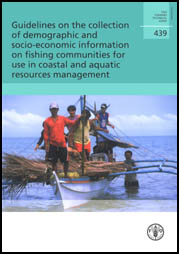|
Villareal, L.V.; Kelleher, V. (ed.); Tietze, U. (ed.)
Guidelines on the collection of demographic and socio-economic information
on fishing communities for use in coastal and aquatic resources management.
FAO Fisheries Technical Paper. No. 439. Rome, FAO. 2004.
120p.
ABSTRACT
Article 10 of the Code of Conduct for Responsible Fisheries (CCRF)
sets out principles and standards for the integration of fisheries in
coastal management. Article 10.2.4 of the CCRF states: “States, in
accordance with their capacities, should establish or promote the establishment
of systems to monitor the coastal environment as part of the coastal management
process using physical, chemical, biological, economic and social parameters.”
The guidelines presented in Part 1 of this Fisheries Technical Paper
attempt to identify empirically verifiable key indicators for the identification
of socio-economic and demographic issues, problems and opportunities in
coastal and aquatic resources management and for monitoring the impact
of management measures on the socio-economic well-being of coastal and
fishing communities. The guidelines also identify data sources and methods
for the collection of data.
Part 2 contains a summary of the proceedings and recommendations of the
Regional Workshop on the Use of Demographic Data in Fisheries and Coastal
Development and Management in the Philippines and other Southeast and
South Asian Countries held at the University of the Philippines in
the Visayas, Miag-ao, Iloilo, Philippines from 18 to 21 March 2002, as
well as selected papers from the workshop.
In Part 3, two case studies, one from the United States of America and
the other from Italy, describe how socio-economic and demographic indicators
are actually used in coastal and aquatic resources management.
|
